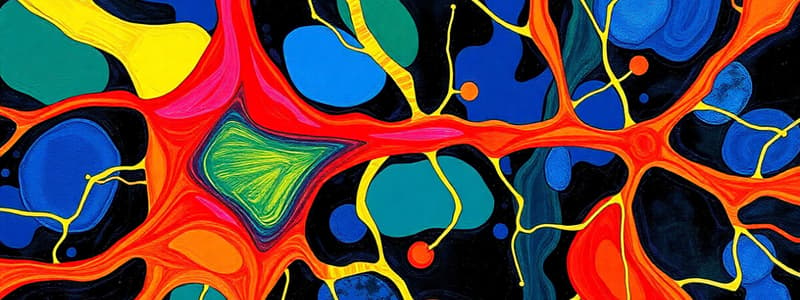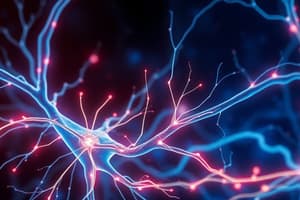Podcast
Questions and Answers
In the context of neuromuscular junction (NMJ) development, if MuSK's kinase activity were selectively abolished via a point mutation, while maintaining its structural integrity for complex formation, what specific downstream effect would be most immediately compromised?
In the context of neuromuscular junction (NMJ) development, if MuSK's kinase activity were selectively abolished via a point mutation, while maintaining its structural integrity for complex formation, what specific downstream effect would be most immediately compromised?
- The release of agrin from the motor neuron terminal
- The clustering of acetylcholine receptors (AChRs) at the synaptic site (correct)
- The translocation of rapsyn to the postsynaptic membrane
- The transcription of AChR subunit genes in muscle nuclei
Assuming a scenario where a novel, potent competitive inhibitor of Dok-7 is introduced at the NMJ, what primary effect would this have in the context of agrin-mediated postsynaptic differentiation?
Assuming a scenario where a novel, potent competitive inhibitor of Dok-7 is introduced at the NMJ, what primary effect would this have in the context of agrin-mediated postsynaptic differentiation?
- Inhibition of the interaction between MuSK and Lrp4. (correct)
- Enhanced clustering of AChRs independently of MuSK signaling.
- Increased expression of rapsyn to compensate for reduced MuSK activation.
- Increased phosphorylation of MuSK due to disinhibition.
Consider a genetic modification that causes a motor neuron to exclusively secrete a truncated form of Agrin, lacking the domain necessary for binding to Lrp4. What is the most likely outcome at the NMJ?
Consider a genetic modification that causes a motor neuron to exclusively secrete a truncated form of Agrin, lacking the domain necessary for binding to Lrp4. What is the most likely outcome at the NMJ?
- Complete absence of AChR clustering and impaired postsynaptic differentiation. (correct)
- Normal AChR clustering due to compensatory mechanisms involving MuSK activation via an alternative pathway.
- Increased synaptic activity leading to compensatory upregulation of AChR expression.
- Enhanced synapse elimination, resulting in fewer but stronger NMJs.
If a specific microRNA (miRNA) is engineered to selectively target and degrade rapsyn mRNA in muscle cells, what is the most immediate and direct consequence on the structural organization of the NMJ, assuming agrin signaling remains intact?
If a specific microRNA (miRNA) is engineered to selectively target and degrade rapsyn mRNA in muscle cells, what is the most immediate and direct consequence on the structural organization of the NMJ, assuming agrin signaling remains intact?
Suppose a novel compound is discovered that selectively enhances the activity of phosphatases that dephosphorylate AChRs. What would be the most likely effect of applying this compound to a fully developed NMJ?
Suppose a novel compound is discovered that selectively enhances the activity of phosphatases that dephosphorylate AChRs. What would be the most likely effect of applying this compound to a fully developed NMJ?
In a scenario where the motor neuron supplying a specific muscle fiber is selectively denervated in vivo, but artificial electrical stimulation is applied to the muscle fiber at a rate mimicking normal synaptic activity, what outcome would you predict regarding AChR expression?
In a scenario where the motor neuron supplying a specific muscle fiber is selectively denervated in vivo, but artificial electrical stimulation is applied to the muscle fiber at a rate mimicking normal synaptic activity, what outcome would you predict regarding AChR expression?
Considering the parallels between NMJ and CNS synapse formation, if a CNS neuron were genetically engineered to express and secrete agrin, but lacked the appropriate scaffolding proteins (e.g., gephyrin at inhibitory synapses), what would be the most likely outcome?
Considering the parallels between NMJ and CNS synapse formation, if a CNS neuron were genetically engineered to express and secrete agrin, but lacked the appropriate scaffolding proteins (e.g., gephyrin at inhibitory synapses), what would be the most likely outcome?
If a neuron-specific knockout of the gene encoding NMDA receptors (NMDARs) is induced in cultured hippocampal neurons, and these neurons are then stimulated with high-frequency stimulation (HFS), what immediate effect would be observed on AMPA receptor (AMPAR) trafficking?
If a neuron-specific knockout of the gene encoding NMDA receptors (NMDARs) is induced in cultured hippocampal neurons, and these neurons are then stimulated with high-frequency stimulation (HFS), what immediate effect would be observed on AMPA receptor (AMPAR) trafficking?
Suppose a mutation leads to accelerated kinetics of GABA release, but a concurrent mutation reduces the affinity of postsynaptic GABAA receptors for GABA. What is the most likely net effect on inhibitory postsynaptic potentials (IPSPs)?
Suppose a mutation leads to accelerated kinetics of GABA release, but a concurrent mutation reduces the affinity of postsynaptic GABAA receptors for GABA. What is the most likely net effect on inhibitory postsynaptic potentials (IPSPs)?
In the context of synapse elimination, if a neuron were engineered to overexpress a dominant-negative form of a pro-apoptotic protein specifically in its axon terminals, what would be the most likely outcome regarding synaptic connectivity?
In the context of synapse elimination, if a neuron were engineered to overexpress a dominant-negative form of a pro-apoptotic protein specifically in its axon terminals, what would be the most likely outcome regarding synaptic connectivity?
Flashcards
Neuromuscular Junction (NMJ)
Neuromuscular Junction (NMJ)
The point of contact between a motor neuron and a muscle fiber; a well-studied model for understanding synapse formation.
One-to-One Connection (NMJ)
One-to-One Connection (NMJ)
Each muscle fiber is innervated by a single motor neuron at the NMJ.
AChR Clustering
AChR Clustering
ACh receptors cluster at the site of contact on the muscle fiber membrane.
Agrin
Agrin
Signup and view all the flashcards
Agrin's Mechanism of Action
Agrin's Mechanism of Action
Signup and view all the flashcards
Rapsyn's Role
Rapsyn's Role
Signup and view all the flashcards
Global Control (Synaptic Activity)
Global Control (Synaptic Activity)
Signup and view all the flashcards
Clustering Signals (CNS)
Clustering Signals (CNS)
Signup and view all the flashcards
Synapse Elimination
Synapse Elimination
Signup and view all the flashcards
Synaptic Maturation
Synaptic Maturation
Signup and view all the flashcards
Study Notes
- The lecture focuses on synapse formation and refinement, with an emphasis on the neuromuscular junction (NMJ) as a model.
- Synapse elimination is introduced as a key process in refining neural circuits.
NMJ: A Model for Synapse Formation
- The NMJ serves as a relatively simple model for understanding synapse formation, in contrast to the complexity of central synapses.
- In the NMJ, each muscle fiber is innervated by a single motor neuron, creating a one-to-one connection.
- Acetylcholine (ACh) functions as the neurotransmitter at the NMJ, facilitating synaptic transmission.
- Acetylcholine receptors (AChRs) cluster on the muscle fiber membrane at the point of contact with the motor neuron axon terminal.
Agrin: Orchestrating Postsynaptic Differentiation
- Agrin, secreted by motor neurons, is identified as a primary inducer of AChR clustering at the NMJ.
- Agrin is produced by both motor neurons and muscle fibers.
- The neuronally-derived form of Agrin is specifically localized to the synaptic basal lamina, a specialized extracellular matrix at the NMJ.
- Agrin binds to a receptor complex on the muscle fiber membrane, including MuSK (muscle-specific kinase), triggering a signaling cascade.
- Activation of MuSK leads to the phosphorylation and clustering of AChRs.
- Agrin-MuSK signaling recruits rapsyn, an intracellular protein essential for anchoring AChRs to the postsynaptic membrane and promoting their aggregation into clusters.
Synaptic Activity: Fine-Tuning Receptor Expression
- Synaptic activity regulates AChR expression levels and fine-tunes synapse formation.
- The overall level of synaptic activity influences AChR gene expression in the muscle fiber.
- Denervation (loss of synaptic input) increases AChR mRNA levels, making the muscle fiber "supersensitive" to ACh.
- Artificially overstimulating the motor neuron decreases AChR expression.
- Synaptic activity exerts local control over AChR density at synaptic sites.
- ACh release from the motor neuron suppresses AChR gene transcription in nearby muscle nuclei, ensuring receptor density remains tightly regulated.
Synapse Formation in the CNS: Parallels and Complexities
- Synapse formation in the CNS is more complex than at the NMJ, involving a wider array of molecular signals and cell types.
- Specific signaling molecules induce the clustering of neurotransmitter receptors on postsynaptic neurons.
- Both the NMJ and central synapses rely on scaffolding proteins to organize the postsynaptic density (PSD) and cluster receptors.
- An example of a scaffolding protein is gephyrin at inhibitory synapses.
Activity-Dependent Regulation in the CNS
- Synaptic activity refines synapses in the CNS
- NMDA receptor (NMDAR) activation can trigger AMPAR internalization, providing a mechanism for activity-dependent synaptic weakening.
Synaptic Maturation: Refining Function
- Synaptic maturation involves changes in receptor subunit composition and functional properties, leading to faster, more efficient synaptic transmission.
- The subunit composition of neurotransmitter receptors, such as GABAA receptors, changes during development, affecting their kinetics and pharmacology.
- Synaptic potentials become shorter in duration during development, partly due to changes in receptor properties, such as faster closing kinetics of NMDARs.
From Progressive to Regressive Events: Shaping Circuits
- Synapse elimination is tightly controlled and refines neuronal connections.
- Synapse elimination, alongside axon and dendrite pruning, transforms the "rough draft" of the nervous system into precise, functional circuits.
Studying That Suits You
Use AI to generate personalized quizzes and flashcards to suit your learning preferences.




